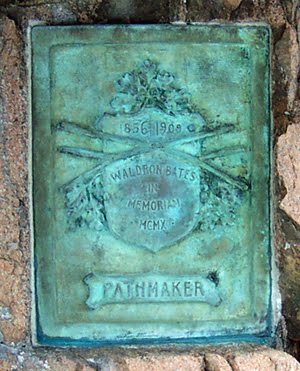This July I had the chance to celebrate my birthday with my family in Yellowstone National Park, Wyoming. It was my 10th visit to this wonderful and exciting park. In addition to enjoying the spectacular scenery and magnificent wildlife, I thought I'd take some time to seek out the Mather memorial.
 |
| Mather |
According to the NPS, "Mather recognized magnificent scenery as the primary criterion for establishment of national parks. He was very careful to evaluate choices for parks, wishing the parks to stand as a collection of unique monuments. He felt those areas which were duplicates might best be managed by others." The beauty and uniqueness of each of the national parks clearly attest to that ambition.
 |
| Mather Memorial Dedication - Yellowstone NP 1932 NPS Historic Photo Collection |
Bronze bas relief memorials to Mather, like the one I sought in Yellowstone NP, were installed in many national parks soon after his death. The memorial in Yellowstone was installed in 1932 and is located at Madison Junction.
 |
| Mather Memorial - Yellowstone NP July 2012 |
 |
| Mather Memorial - Acadia National Park |
Acadia National Park in Maine has a Mather memorial, also installed in 1932, on the summit of Cadillac Mountain.
 |
| Mather Memorial - Big Bend National Park |
In 2010, upon returning from a trip to Australia, I located another Mather memorial in the Chisos Basin of Big Bend National Park, Texas.
 |
| Stephen Tyng Mather NPS photo |
STEPHEN TYNG MATHER
JULY.4.1867 JAN.22.1930
HE LAID THE FOUNDATION
OF THE NATIONAL PARK
SERVICE DEFINING AND ESTABLISHING
THE POLICIES
UNDER WHICH ITS AREAS
SHALL BE DEVELOPED AND
CONSERVED UNIMPAIRED
FOR FUTURE GENERATIONS.
THERE WILL NEVER COME AN END TO THE GOOD THAT
HE HAS DONE.
It is my goal to find the Mather memorials in the national parks I visit and pause to remember the "Father" of the U.S. National Park Service and appreciate the good that he has done for us. Perhaps you will now also engage in this interesting quest.
GPS coordinates:
Mather memorial in Acadia NP: N44° 21.148' W068° 13.454'
Mather memorial in Yellowstone NP: N44° 38.538' W110° 51.741'



